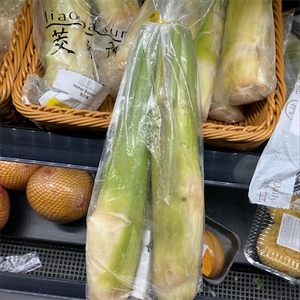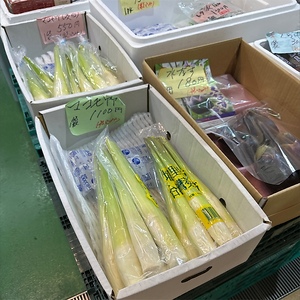


Water Bamboo Shoots
Estimated Inventory, lb : 0
Description/Taste
Water Bamboo shoots are harvested for commercial purposes when the stems are 3 to 4 centimeters in diameter and 20 to 30 centimeters in length, and the shoots have a long, straight, and tapered appearance. The stems in the wild can grow to be much longer, but they are trimmed and cut for markets to be more consumer-friendly. The swollen stems are covered in layers of husk-like leaves, showcasing a white base transitioning into pale yellow and green hues. Each exterior layer has a textured, semi-rough, and fibrous nature due to striations extending the length of the shoot. As the outer leaf layers are stripped from the stem, the shoots become softer and more tender in nature. The interior of the shoot reveals a white, thick, spongy, tender, and crisp flesh. Look for young shoots that feel lightweight and fresh. Older shoots will develop black spots and become tougher in nature, indicating that the quality and flavor have declined. Water Bamboo shoots release a green, subtly sweet, corn-like scent and can be eaten raw or cooked. Fresh shoots have a mild, refreshing, light, sweet, neutral, and earthy taste. When cooked, the shoots develop a more pronounced, sweeter flavor reminiscent of bamboo shoots and retain their crisp texture.
Seasons/Availability
Water Bamboo shoots are available for a short season from mid-summer through fall.
Current Facts
Water Bamboo shoots, botanically classified as Zizania latifolia, are the stems of a perennial plant belonging to the Poaceae family. The species is native to Asia and can grow 1.2 to 3.5 meters in height, and several portions of the plants are edible, including the stems and seeds. Historically, Water Bamboo shoots were cultivated as a grain crop, and the seeds were the primary element sourced from the plant. Over time, it was discovered that a smut fungus, Ustilago esculenta, was infecting the plants, causing the base of the stems to swell. The cells inside the stem expand and overproduce, creating edible fleshy, crisp, and tender shoots. After this discovery, the plants were grown exclusively for these swollen stems, and farmers allowed the fungus to infect the plants. It is important to note that this fungus is harmless to humans, and the stems are consumed before spores of the fungus appear. Water Bamboo shoots are known by several regional names throughout Asia, including Makomotake, Makomo, and Hanagatatsumi in Japan, Water Bamboo in Taiwan, Jiao Bai in China, and Coba. In the modern day, the swollen stems are only harvested for a short season spanning from July through early November, and the species is primarily a cultivated plant, rarely found in the wild. Water Bamboo shoots are edible raw or cooked and are prepared as a vegetable in culinary applications.
Nutritional Value
Water Bamboo shoots are a source of vitamin C to strengthen the immune system, iron to develop the protein hemoglobin for oxygen transport through the bloodstream, calcium to build strong bones and teeth, and vitamin A to maintain healthy organ functioning. In Traditional Chinese Medicine, Water Bamboo shoots are a yin food consumed to remove heat and act as a natural diuretic to detox the body. The shoots are also used to support liver functions, relieve thirst in the body, and moisten the digestive tract. Beyond vitamins and minerals, if the stems are left to develop spores, the flesh turns black and becomes known as makozumi. The black flesh is made into a dye-like substance traditionally used in Japan to darken eyebrows, color fabrics, or blacken teeth, a cosmetic practice to show beauty and maturity in the Heian period.
Applications
Water Bamboo shoots have a mild and subtly sweet taste suited for fresh or lightly cooked preparations. The stems should be stripped of leaves and tough layers and washed. Once prepped, the stems can be eaten raw as a crunchy snack, shredded into rice dishes, chopped into salads, or sliced and served as an edible garnish. Water Bamboo shoots are most popularly cooked, and it is recommended to only heat the stems in quick cooking methods to preserve the shoots' flavor and crisp texture. Water Bamboo shoots are traditionally added to soups and stir-fries throughout Southeast and East Asia. In Taiwan, Water Bamboo shoots are known as Water Bamboo and are often grilled and glazed in a barbeque sauce as a festive dish during the Mid-Autumn Festival. In China, the shoots are famously stir-fried with pork as a flavorful main dish. The stems are also sautéed with aromatics or steamed and served in a sauce. In Japan, Water Bamboo shoots are grilled whole over charcoal, stripped of the outer layers, and served with miso, soy sauce, or bonito flakes. The shoots are also incorporated into miso soup, fried into tempura, or simmered in dashi. The city of Nam Dinh in Vietnam is famous for a dish using Water Bamboo shoots. The regional dish consists of stir-fried Water Bamboo shoots cooked with aromatics, beef, and eggs. Water Bamboo shoots are also a favored souvenir from Nam Dinh, and visitors travel from all over Asia to purchase the signature stems. Water Bamboo shoots pair well with herbs such as chives, dill, scallions, and cilantro, aromatics including garlic, chile peppers, soy sauce, sesame oil, and onions, and spices such as ginger, white pepper, and curry powder. Whole, unwashed Water Bamboo shoots should be stored in a plastic bag and kept in the refrigerator's vegetable drawer. Water Bamboo shoots can also be blanched and stored in the freezer or pickled for extended use.
Ethnic/Cultural Info
Water Bamboo shoots, known as Makomo and Makomotake in Japan, are famously used to weave the shimenawa for the Izumo Grand Shrine in the Shimane Prefecture. The Grand Shrine, known as Izumo-Taisha and Izumo Oyashiro, is one of the oldest Shinto shrines in Japan. A shimenawa is a straw rope symbolically hung above a shrine's entrance to mark the beginning of sacred space and keep the world's impurities from the gods enshrined inside. "Shime" translates to "embrace" or "hold," while "nawa" means "rope," and these ropes are traditionally woven from local plants. The shimenawa in the Grand Shrine is hung in front of Kaguraden Hall and is over 13.5 meters in length, the largest shimenawa in Japan. The rope weighs around 4.5 tons and is constructed from dried Water Bamboo leaves woven into the shape from left to right. The massive shimenawa is re-made every 6 to 8 years, and it generally takes over 800 volunteers, 3 hectares of Water Bamboo leaves, and over three months to create the rope. It is thought that the act of creating a shimenawa is tied to Water Bamboo farming, as farmers would place a shimenawa in their field to welcome a good harvest.
Geography/History
Water Bamboo shoots are native to Asia, and wild populations have been found in northern China, Japan, Taiwan, southern Russia, and Korea. The species was also spread to regions of Southeast Asia, where the plants naturalized in Myanmar, northeastern India, Vietnam, Cambodia, Thailand, and Laos. Water Bamboo shoots were once cultivated for their seeds and were grown as a grain crop in China sometime before the Tang Dynasty from 618 to 907 CE. Over time, the parasitic fungus appeared in the plants, causing the stems to swell. It was eventually discovered that these stems were edible, leading farmers to switch from cultivating the plants as grain to growing the plants as vegetables. Water Bamboo shoots are mentioned in the ancient text, the Book of Rites, a collection of written pieces completed in the Zhou Dynasty, from 1046 to 771 BCE. The plants spread throughout East Asia and into Southeast Asia as commercial and wild vegetables, and the swollen stems became such a favored ingredient that it was commonly mentioned in poetry and other written works. In the 20th century, Water Bamboo shoots were introduced to New Zealand and were planted in Dargaville in Northland. The species quickly became an aggressive invasive species, and efforts are being made in New Zealand to control the population. The United States is also taking efforts to prevent the introduction of the species to protect a North American species similar to the Asian cultivar. Today, Water Bamboo shoots thrive along riverbanks, swamp edges, wetlands, rice paddy fields, and other water-filled locations. The plants are extensively produced for commercial sale in China and Japan. In China, the species is found along the lower Yangtze River and throughout northeastern China. In Japan, the plants are grown in the Mie, Ishikawa, Saga, Shiga, Toyama, Yamagata, and Nagano Prefectures. When in season, Water Bamboo shoots are sold through fresh markets, select grocers, and distributors. The Water Bamboo shoots featured in the photograph above were sourced from Tsukiji Market in Tokyo, Japan.
Recipe Ideas
Recipes that include Water Bamboo Shoots. One
| Healthy World Cuisine |
|
Shrimp and Wild Rice Stem |
| Storm In My Kitchen |
|
Chili Wild Rice Shoots with Pork and Mushrooms |










